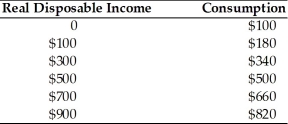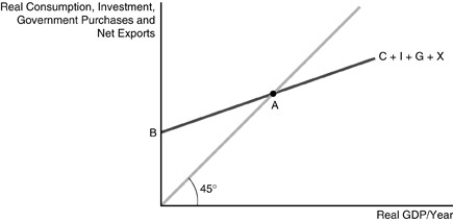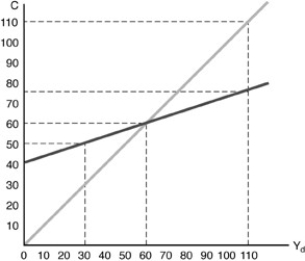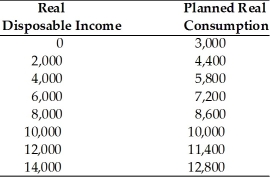A) 5.0.
B) 1.2.
C) 0.2.
D) 0.8.
Correct Answer

verified
Correct Answer
verified
Multiple Choice
 -In the above table, saving equals zero when real disposable income equals
-In the above table, saving equals zero when real disposable income equals
A) $0.
B) $200.
C) $300.
D) $500.
Correct Answer

verified
Correct Answer
verified
Multiple Choice
 -Refer to the above figure. Point B
-Refer to the above figure. Point B
A) equals autonomous consumption.
B) equals autonomous consumption plus autonomous consumption plus planned investment plus autonomous government spending plus autonomous net exports.
C) has no special significance.
D) equals government expenditures.
Correct Answer

verified
Correct Answer
verified
Multiple Choice
Investment spending is
A) directly related to the interest rate.
B) inversely related to the interest rate.
C) directly related to real disposable income.
D) inversely related to real disposable income.
Correct Answer

verified
Correct Answer
verified
Multiple Choice
 -Consider the above figure. The equation for the saving function is
-Consider the above figure. The equation for the saving function is
A) S = 40 - 0.67 Yd.
B) S = 40 + 0.33 Yd.
C) S = -40 + 0.67 Yd.
D) S = -40 - 0.33 Yd.
Correct Answer

verified
Correct Answer
verified
Multiple Choice
Which of the following is FALSE?
A) APC + MPS = 1
B) MPC + MPS = 1
C) 1 - APC = APS
D) APC + APS = 1
Correct Answer

verified
Correct Answer
verified
Multiple Choice
The marginal propensity to consume (MPC) can best be defined as that fraction of
A) real disposable income that is consumed.
B) real disposable income that is not consumed.
C) a change in real disposable income that is spent.
D) a change in real disposable income that is saved.
Correct Answer

verified
Correct Answer
verified
Multiple Choice
At the point at which the consumption function intersects the 45 degree reference line
A) planned real consumption equals real disposable income.
B) equilibrium output is supply determined equilibrium output is determined by both.
C) planned real saving equals real disposable income.
D) planned real consumption of real disposable income equals zero.
Correct Answer

verified
Correct Answer
verified
Multiple Choice
If saving equals $200 when real disposable income equals $1,000, the break-even income is
A) less than $1,000.
B) greater than $1,000.
C) equal to $1,000.
D) equal to $1,200.
Correct Answer

verified
Correct Answer
verified
Multiple Choice
 -Refer to the above table. The table gives the combinations of real disposable income and real consumption for a college student for a year. What is the value of the average propensity to save equal when real disposable income equals $14,000?
-Refer to the above table. The table gives the combinations of real disposable income and real consumption for a college student for a year. What is the value of the average propensity to save equal when real disposable income equals $14,000?
A) 0.09
B) 0.7
C) 0.91
D) 1.1
Correct Answer

verified
Correct Answer
verified
Multiple Choice
If real disposable income increases, the average propensity to save will
A) initially increase, and then decrease.
B) remain constant.
C) increase.
D) decrease.
Correct Answer

verified
Correct Answer
verified
Multiple Choice
The size of the multiplier depends on
A) the level of autonomous investment.
B) the marginal propensity to consume.
C) the level of net exports.
D) the level of autonomous consumption.
Correct Answer

verified
Correct Answer
verified
Multiple Choice
Which of the following is a simplifying assumption associated with the short-run Keynesian model of equilibrium real Gross Domestic Product (GDP) determination?
A) Gross private domestic investment exceeds net private domestic investment.
B) Most business profits are distributed to shareholders.
C) Businesses pay indirect taxes.
D) There is no depreciation.
Correct Answer

verified
Correct Answer
verified
Multiple Choice
A situation in which spending exceeds income is
A) the consumption function.
B) the saving function.
C) average propensity to save.
D) dissaving.
Correct Answer

verified
Correct Answer
verified
Multiple Choice
Which of the following is TRUE?
A) APC + MPS = 1
B) MPC + MPS = 1
C) 1 + APC = APS
D) APC - APS = 1
Correct Answer

verified
Correct Answer
verified
Multiple Choice
Government purchases
A) are determined by the public.
B) are determined by the political process.
C) are influenced by interest rates.
D) are determined by suppliers.
Correct Answer

verified
Correct Answer
verified
Multiple Choice
The arithmetic value of (1 - MPC) equals
A) APC.
B) MPS.
C) APS.
D) NDP.
Correct Answer

verified
Correct Answer
verified
Multiple Choice
 -Refer to the above table. The table gives the combinations of real disposable income and real consumption for a college student for a year. The break-even level of real disposable income is
-Refer to the above table. The table gives the combinations of real disposable income and real consumption for a college student for a year. The break-even level of real disposable income is
A) 0.
B) 6,000.
C) 10,000.
D) 14,000.
Correct Answer

verified
Correct Answer
verified
Multiple Choice
According to Keynes, real saving and real consumption spending are functions of
A) economic expectations.
B) an individual's future earning potential.
C) current educational attainment.
D) current real disposable income.
Correct Answer

verified
Correct Answer
verified
Multiple Choice
The average propensity to save (APS) is
A) the rate at which real savings changes over time.
B) the percentage of real disposable income saved.
C) the difference between the amounts of real disposable income consumed and saved.
D) the percentage of additional real disposable income that will go toward real saving.
Correct Answer

verified
Correct Answer
verified
Showing 181 - 200 of 445
Related Exams